Choosing the Best Solar Battery Backup for Reliable Power Storage
Solar energy is transforming how we power our homes and businesses. With the rising need for reliable energy solutions, solar battery backup systems are becoming essential. They not only store excess energy generated during the day but also provide backup power during outages. This article will explore the ins and outs of solar battery backup solutions and how they can help you achieve energy independence.

Key Takeaways Solar Battery Backup
- Solar battery backup systems store energy for use during outages and peak demand times.
- They help maximize the efficiency of solar panels by utilizing stored energy instead of sending it back to the grid.
- Choosing the right battery technology is crucial for meeting your energy needs and ensuring longevity.
- Integrating solar batteries with your existing energy system enhances your overall energy independence.
- Advancements in battery technology are making solar battery backup solutions more accessible and effective.
Understanding Solar Battery Backup Systems
What Is a Solar Battery Backup?
A solar battery backup system is essentially a way to store the extra energy your solar panels generate. Instead of sending excess power back to the grid, it’s stored in a battery for later use. This is especially useful when the sun isn’t shining, like at night or during a power outage. It’s a key component for anyone looking to maximize their solar investment and achieve greater energy independence. Think of it as your own personal power reserve. It’s also important to consider the best solar battery backup system for home use to ensure you’re getting the most efficient and reliable setup for your needs.
How Do Solar Batteries Work?
Solar panels convert sunlight into DC (Direct Current) electricity. This electricity powers your home, and any surplus is sent to a solar battery. The battery stores this energy, usually converting it to AC (Alternating Current) when needed. When your panels aren’t producing enough power, the battery kicks in, supplying electricity to your home. This cycle ensures a continuous power supply, reducing your reliance on the grid. Inverters are a key component in this process, managing the flow of electricity.
Key Components of a Solar Battery System
A solar battery system isn’t just a battery; it’s a collection of components working together. Here’s a breakdown:
- Solar Panels: These capture sunlight and convert it into electricity.
- Inverter: Converts DC electricity from the panels or battery into AC electricity for your home.
- Battery: Stores the excess energy generated by the solar panels.
- Charge Controller: Regulates the flow of electricity to the battery, preventing overcharging and damage.
A well-designed solar battery system should seamlessly integrate with your existing solar panels and home electrical system. Compatibility is key for optimal performance and longevity. Consider consulting with a professional installer to ensure all components work together efficiently.
Benefits of Solar Battery Backup Solutions
Reliable Power During Outages
Okay, so power outages are getting more common, right? Between crazy weather and the grid just being old, it’s a thing. A solar battery backup is like having your own personal power plant when the lights go out. It keeps the essentials running – fridge, lights, maybe even the TV if you’re lucky. It’s peace of mind, plain and simple. No more scrambling for candles or worrying about food spoiling. Solar batteries are a great solution for reliable power.
Maximized Energy Efficiency
Think of it this way: your solar panels are cranking out energy all day. Without a battery, any extra juice gets sent back to the grid. Which is fine, you might get a little credit. But with a battery? You’re storing that energy for later. It’s like saving leftovers instead of throwing them away. You’re using every bit of that solar power, making your system way more efficient. No waste, all power to you.
Lower Utility Costs
Here’s where it gets really good. Utility companies charge more during peak hours, right? Everyone’s using power, so they jack up the prices. But with a solar battery, you can skip all that. You use the energy you stored during the day, instead of buying it from the grid at those crazy high rates. Over time, that adds up to some serious savings. It’s like getting a discount on electricity, every single day. Plus, you get to tell the power company you don’t need them as much anymore. That’s always a good feeling.
Solar batteries aren’t just about saving money, though that’s a big part of it. They’re about taking control of your energy, being more self-sufficient, and doing your part for the environment. It’s a win-win-win, if you ask me.
Choosing the Right Solar Battery Technology

Types of Solar Batteries
Okay, so you’re thinking about getting a solar battery. Cool! First thing’s first: there are different types of batteries out there. You’ve got your lead-acid, which are the old-school, cheaper option. Then there are lithium-ion batteries, which are more expensive but last longer and are more efficient. There are also some newer technologies like redox flow and sodium nickel chloride, but those aren’t as common yet. It’s kind of like choosing between a flip phone and a smartphone – both make calls, but one’s way more advanced.
Factors to Consider When Choosing
Choosing the right battery isn’t just about picking the fanciest one. You gotta think about a few things. First, what’s your energy usage like? How much power do you typically use, especially at night or during outages? This will help you figure out the capacity you need. Also, think about durability. You want a battery that’s going to last a while, so look at things like depth of discharge and cyclic life. And don’t forget about the temperature where you’re installing it – some batteries don’t do well in extreme heat or cold. Finally, make sure it’s compatible with your solar panels. You don’t want to end up with a system that doesn’t work together.
Comparing Popular Battery Brands
Alright, let’s talk brands. Tesla Powerwall is a big name – sleek design, lots of capacity (around 13.5 kWh). LG Chem RESU is another popular choice, known for being reliable and working with different solar setups. It really depends on what you’re looking for and how much you’re willing to spend. Do some research, read reviews, and maybe talk to a solar installer to get their opinion.
Picking a solar battery is a big decision, so don’t rush into it. Think about your needs, do your homework, and choose a battery that’s going to keep your lights on for years to come.
Here’s a quick comparison table:
| Feature | Tesla Powerwall | LG Chem RESU | Lead-Acid (Generic) |
|---|---|---|---|
| Capacity | 13.5 kWh | ~10 kWh | Varies |
| Lifespan | High | High | Moderate |
| Cost | Higher | Moderate | Lower |
| Compatibility | Good | Good | Varies |
| Temperature Sens. | Moderate | Moderate | High |
Integrating Solar Batteries with Your Energy System
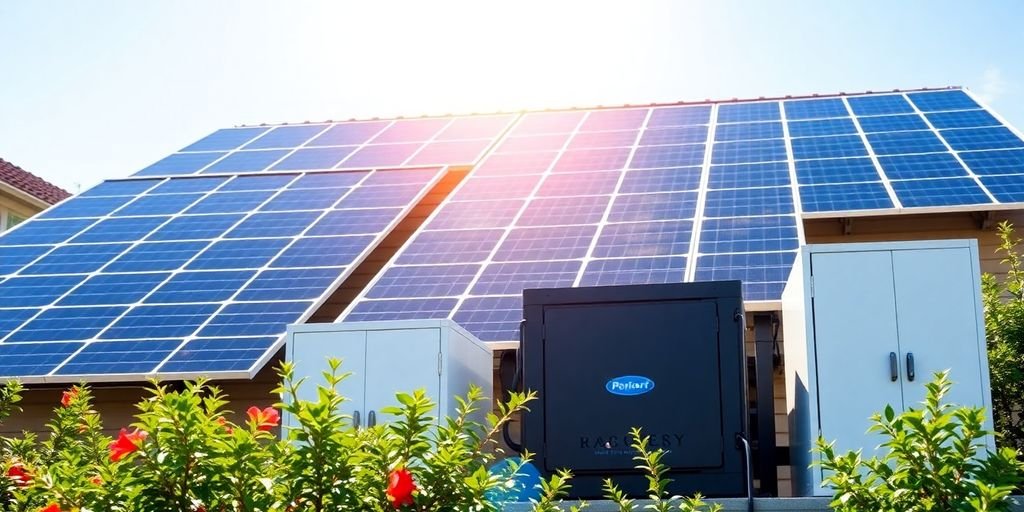
Optimizing Solar Panel Performance
To really get the most out of your solar panels, think about how they work with your new battery. It’s not just about slapping them together; it’s about making them synergize. Proper sizing of your solar array is key – you want enough panels to charge the battery fully, but not so many that you’re constantly wasting excess energy. Consider the angle and direction of your panels, too. Are they catching the most sunlight possible throughout the day? Regular cleaning is also a must; dusty panels are less efficient panels.
Creating a Hybrid Energy System
Okay, so you’ve got solar panels and a battery. Now what? A hybrid system blends these with your existing grid connection. This setup gives you the best of both worlds: independence and reliability. Here’s how to think about it:
- Grid-tied with battery: You use solar energy first, then battery, and finally, the grid. This lowers your bills and gives you backup power.
- Off-grid: You’re completely disconnected from the grid, relying solely on solar and battery. This requires careful planning and a larger battery capacity.
- Grid-tied with sell-back: You can sell excess solar energy back to the grid, earning credits on your bill. Check your local utility’s policies.
Integrating a hybrid system is a big step towards energy independence. It’s about finding the right balance between solar, battery, and grid power to meet your specific needs and goals. It’s not a one-size-fits-all solution, so do your homework!
Enhancing Energy Independence
Want to ditch the utility company as much as possible? That’s energy independence! A solar battery is a huge step in that direction. By storing excess energy, you’re less reliant on the grid, especially during peak hours or outages. Think about it: no more worrying about rising energy costs or blackouts. You’re in control. To maximize your solar power potential, consider these points:
- Monitor your energy usage: Understand when and how you use the most energy.
- Optimize battery settings: Adjust your battery’s settings to prioritize self-consumption or backup power.
- Consider a smart home system: Automate your energy usage to further reduce grid reliance.
Here’s a simple table showing potential savings:
| Scenario | Grid Reliance | Estimated Savings |
|---|---|---|
| Solar Only | 60% | 30% |
| Solar + Battery | 20% | 70% |
| Solar + Battery + Automation | 10% | 85% |
Remember, energy independence isn’t just about saving money; it’s about taking control of your energy future.
The Future of Solar Battery Backup
Advancements in Battery Technology
Battery tech is moving fast. We’re seeing improvements in energy density, meaning batteries can store more power in a smaller space. Lithium-ion is still the dominant player, but other chemistries like solid-state and flow batteries are gaining traction. These could offer better safety, longer lifespans, and improved performance. It’s not just about the chemistry either; software and battery management systems are getting smarter, optimizing how batteries charge and discharge to extend their life and efficiency.
Impact on Energy Independence
Solar battery backup is becoming more accessible and affordable, which is a big deal for energy independence. As battery prices drop and performance improves, more people can cut ties with the traditional grid. This means less reliance on utility companies and more control over your own power. Imagine a future where homes and businesses generate and store their own energy, creating a decentralized and resilient energy system. That future is getting closer thanks to advancements in solar and battery tech.
Trends in Solar Energy Storage
Several trends are shaping the future of solar energy storage:
- Increased adoption of home energy management systems: These systems allow homeowners to monitor and control their energy usage, optimizing the performance of their solar and battery systems.
- Growth of virtual power plants (VPPs): VPPs aggregate the energy storage capacity of many homes and businesses, creating a distributed energy resource that can be used to support the grid.
- Development of longer-duration storage solutions: While most batteries provide a few hours of backup power, there’s a growing need for solutions that can store energy for days or even weeks. This is especially important for areas with unreliable grid service.
The convergence of solar power and battery storage is not just a trend; it’s a transformation. It’s about empowering individuals and communities to take control of their energy future, creating a more sustainable and resilient world.
Here’s a quick look at projected battery costs:
| Year | Projected Cost per kWh |
|---|---|
| 2025 | $300-400 |
| 2030 | $200-300 |
| 2035 | $150-250 |
Real-World Applications of Solar Battery Backup
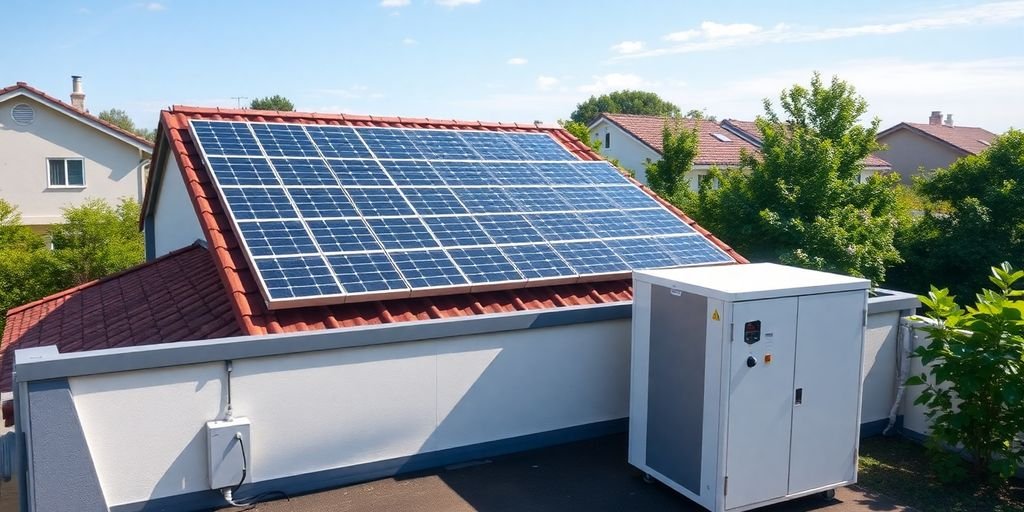
Residential Use Cases
For homeowners, solar battery systems offer a sense of security and cost savings. Imagine a summer storm knocks out the power; instead of fumbling for candles, your lights stay on, your fridge keeps running, and your internet remains connected. Solar batteries allow you to use the energy your panels generate during the day, even after the sun sets. This is especially useful during peak hours when electricity rates are highest.
- Reduced energy bills by using stored solar power instead of grid electricity.
- Backup power during outages, ensuring essential appliances continue to function.
- Increased home value, as solar battery systems are an attractive feature for potential buyers.
Solar battery backup isn’t just about saving money; it’s about peace of mind. Knowing you have a reliable power source during emergencies is invaluable.
Commercial Benefits
Businesses can also reap significant rewards from solar battery backup. Power outages can lead to lost revenue, damaged equipment, and disrupted operations. A solar battery system can mitigate these risks, providing a continuous power supply.
- Reduced downtime during power outages, minimizing financial losses.
- Protection of sensitive equipment from power surges and fluctuations.
- Enhanced sustainability efforts, attracting environmentally conscious customers.
Case Studies of Successful Implementations
Let’s look at some real-world examples. The Hornsdale Power Reserve in Australia, featuring Tesla lithium-ion batteries, is one of the world’s largest battery storage projects. It provides grid stability services, including frequency regulation and backup power during outages. Similarly, the Kauai Island Utility Cooperative in Hawaii combines solar power with lithium-ion battery storage to reduce reliance on fossil fuels and stabilize the grid. Green Mountain Power in Vermont deployed residential Tesla Powerwall batteries alongside solar installations to offer customers backup power during grid outages and help manage peak demand. These projects demonstrate the versatility and effectiveness of solar battery backup in diverse settings.
| Project | Location | Key Benefit |
|---|---|---|
| Hornsdale Power Reserve | South Australia | Grid stability, backup power |
| Kauai Island Utility Coop. | Hawaii | Reduced fossil fuel reliance, grid stability |
| Green Mountain Power | Vermont | Backup power, peak demand management |
Overcoming Challenges with Solar Battery Backup
Common Misconceptions
There are a few things people often get wrong about solar battery backups. One big one is thinking they’re totally maintenance-free. While they don’t need constant attention, periodic checks are important to keep them running smoothly. Another misconception is that any solar panel will work perfectly with any battery. Compatibility is key, and it’s something you need to consider when setting up your system. People also underestimate the space needed for installation. These batteries can take up a fair amount of room, so planning is essential.
Addressing Installation Concerns
Installing a solar battery backup isn’t always a walk in the park. It’s more than just plugging things in. Here’s what you should keep in mind:
- Professional Installation: Unless you’re an experienced electrician, leave it to the pros. Incorrect installation can be dangerous and void warranties.
- Permitting and Regulations: Check local codes and regulations. You might need permits before you can start the installation.
- System Design: Make sure the system is designed to meet your specific energy needs. A one-size-fits-all approach rarely works.
Getting the installation right from the start can save you a lot of headaches down the road. It’s worth investing in a qualified installer who knows their stuff.
Maintenance and Longevity Issues
To keep your solar battery backup running for years, you need to stay on top of maintenance. Here are some things to consider:
- Regular Inspections: Check the battery’s condition, wiring, and connections regularly.
- Temperature Control: Batteries perform best within a specific temperature range. Make sure they’re not exposed to extreme heat or cold.
- Software Updates: Some batteries have software that needs updating to optimize performance and extend lifespan.
Here’s a quick look at estimated lifespans for different battery types:
| Battery Type | Estimated Lifespan |
|---|---|
| Lithium-Ion | 5-15 years |
| Lead-Acid | 3-5 years |
| Flow | 10-20 years |
Remember, proper maintenance can significantly extend the life of your solar power system.
Final Thoughts on Solar Battery Backup Solutions
In the end, investing in a solar battery backup system is a smart move for anyone looking to take charge of their energy use. With the way power outages are becoming more frequent, having a reliable backup can really make a difference. Plus, it helps you save money on those high utility bills by letting you use your own stored energy instead of relying on the grid. And let’s not forget about the environmental benefits—using solar energy cuts down on fossil fuel use and helps reduce your carbon footprint. So, if you’re serious about energy independence and want to make the most of your solar setup, adding a battery is definitely worth considering.
Frequently Asked Questions
What is a solar battery backup system?
A solar battery backup system stores extra energy from your solar panels so you can use it later, especially during power outages or at night.
How does a solar battery work?
Solar batteries collect energy produced by solar panels during the day. This energy is saved for later use when the sun isn’t shining.
What are the main parts of a solar battery system?
The main parts include solar panels that collect sunlight, the battery that stores energy, and an inverter that changes the stored energy into usable electricity.
What are the benefits of having a solar battery?
Solar batteries provide backup power during outages, help you save on energy bills, and increase your energy independence by reducing reliance on the grid.
How do I choose the right solar battery for my home?
Consider factors like the battery’s capacity, durability, and how much sunlight your solar panels receive. This will help you find the best battery for your needs.
What challenges come with solar battery systems?
Some challenges include misconceptions about their cost, concerns about installation, and the need for regular maintenance to keep them working well.

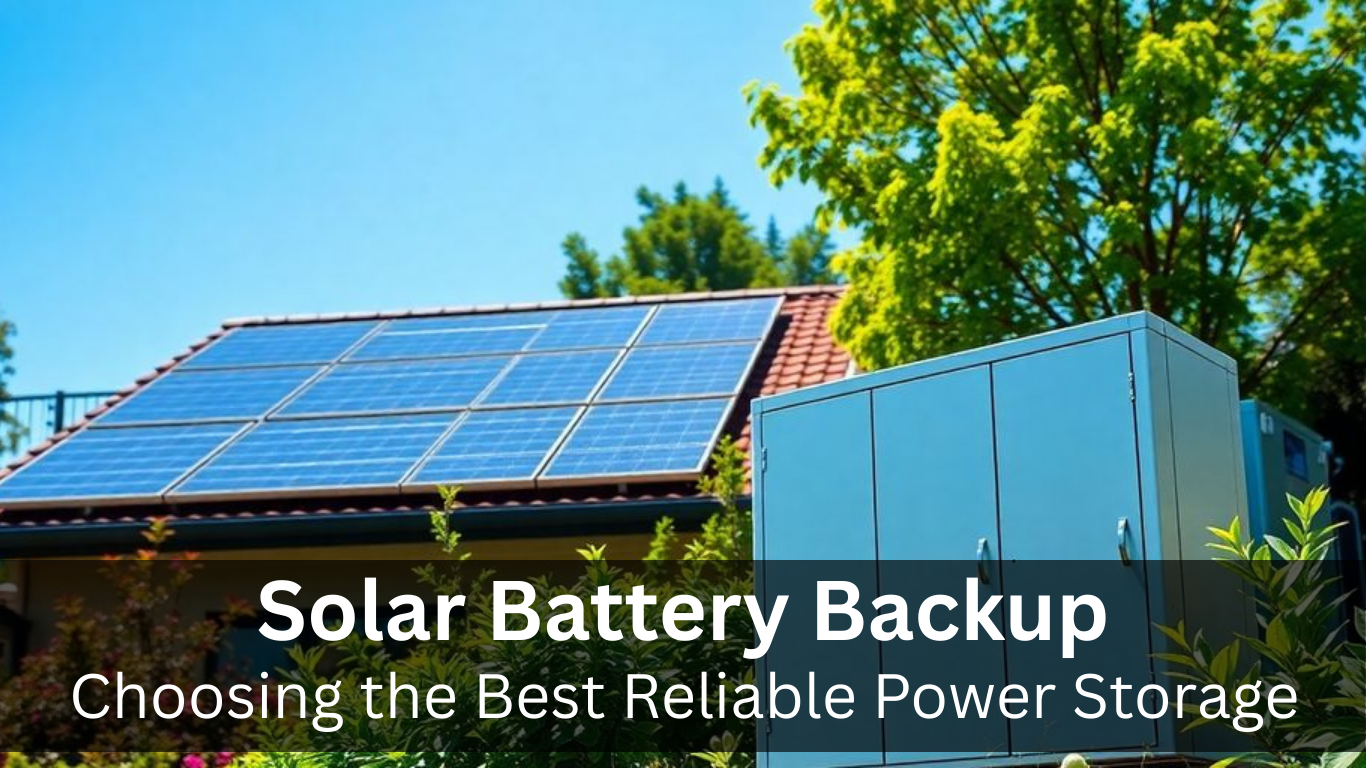


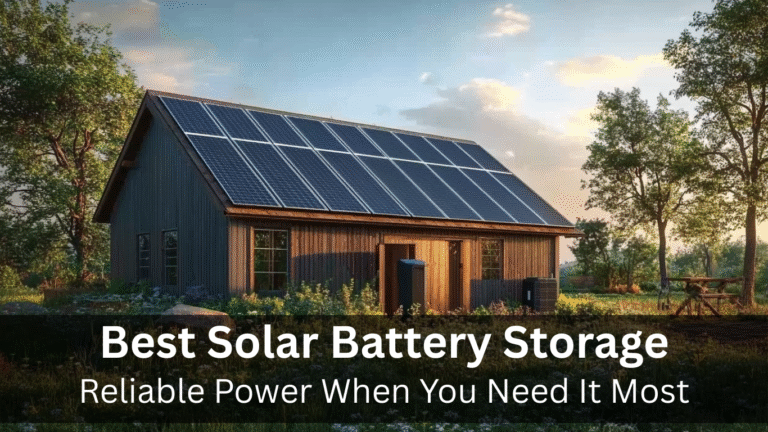
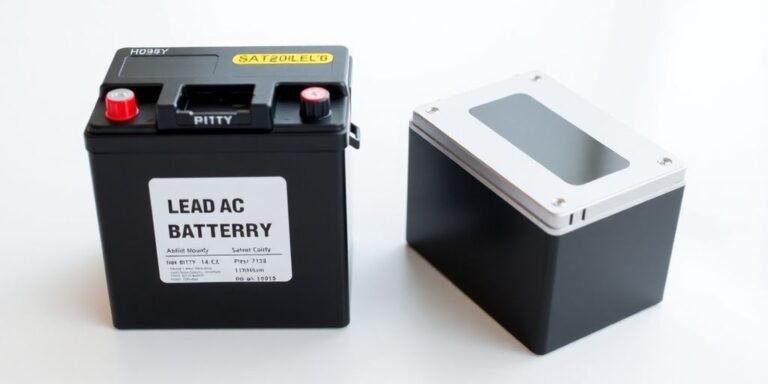

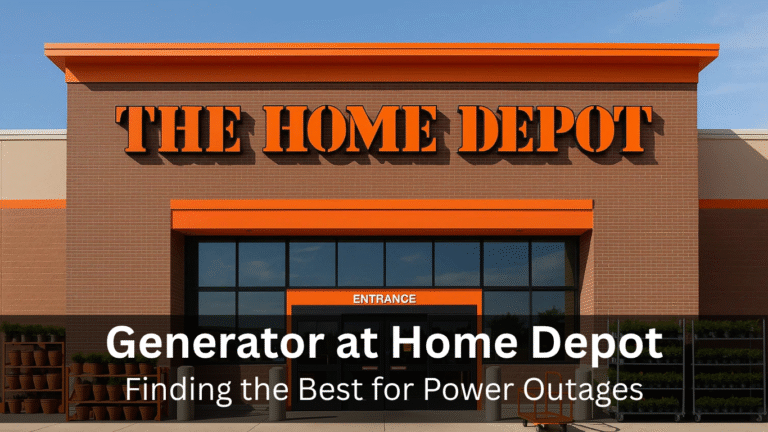

4 Comments